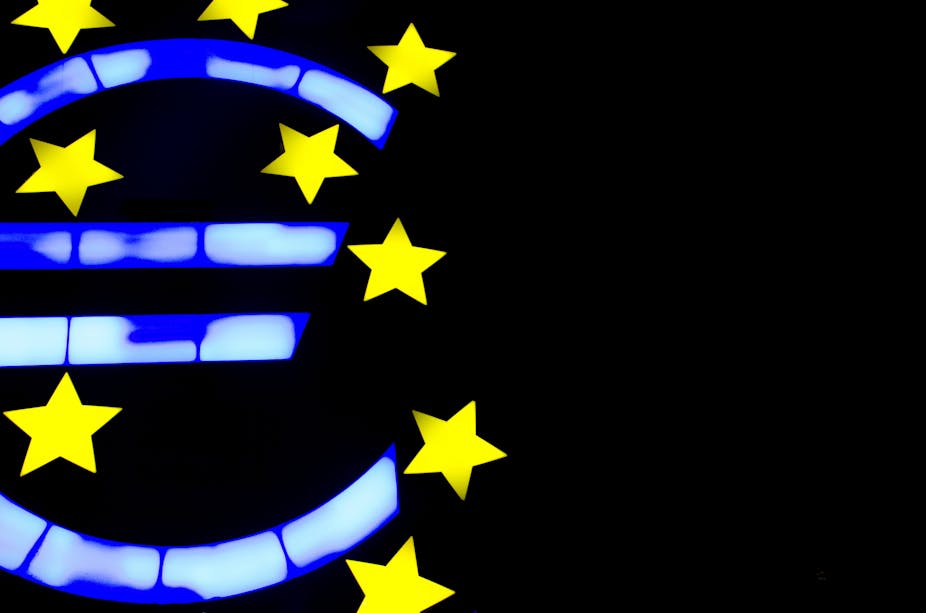It’s very unlikely that the European Central Bank expected the publication of its Governing Council minutes – now posted online for the first time – to reassure financial markets or boost industrial confidence. In fact, its intention may well have been the opposite: to remind member governments of the utter disarray in which the eurozone now finds itself, so as to spark the political action that’s essential for survival.
The record of the January 21-22 meeting, at which the ECB agreed to keep interest rates at record lows and find new ways to pump money into the economy, shows a central bank at the limit of its legal powers and of its understanding of the shocks to come.
The main decision at last month’s meeting was to launch the ECB into quantitative easing (QE), buying financial assets so that governments (and, indirectly, private companies) can borrow at even lower cost than present rock-bottom interest rates allow. This additional monetary stimulus was bigger than financial markets expected, and initially seemed to cheer them. But the minutes show a Council deeply divided on all aspects of that decision.
Some members opposed the intervention altogether, “as the cost-benefit assessment of the proposed measures was not positive in their view”. To others, “there appeared to be no urgent need for monetary policy action”. Among those who agreed with the need for QE “the point was made that purchases of corporate bonds… could be seen as the most natural extension” of present ECB policy.
Yet low interest rates and previous asset-buying from the private sector haven’t persuaded it to start spending again. So the meeting concluded that “purchases of sovereign debt appeared to be the only remaining instrument of sufficient scope to provide the necessary monetary stimulus”.
That’s all, folks
This division of opinion reflects a deeper desperation. The ECB no longer believes its actions will be enough to revive investment and growth in the eurozone. It now merely hopes to arrest the fall in prices and push the inflation rate back up towards its 2% target. If prices don’t stabilise, real borrowing costs will rise, despite the near-zero nominal rate, and buyers will postpone non-essential purchases, further undermining economic recovery.
A generalised price fall – deflation – still wasn’t entirely evident in mid-January, as the minutes make clear. But data released since then show a eurozone price drop of 0.6% year-on-year in January – worse than the 0.2% fall in December, when prices were already falling in 11 of the then 18 Eurozone members.
This drop is mainly due to the global fall in oil and gas prices, which have halved since mid-2014. As a net importer of fossil fuels, the eurozone should be boosted by this. But even here, opinion divides among ECB governors. Some cautioned that weak oil prices could be partly a result of the eurozone’s lack of growth, rather than a solution to it; others that lower energy bills might lead households and businesses to save more or pay off their debts, rather than spend their way out of recession.
When even a tumbling oil price can’t revive a region’s economy, it needs more stimulus than monetary policy can provide. ECB governors are clearly addressing their member governments – above a grinding of teeth rather than the roar of printing presses – when they observe that “the expected stimulus via funding cost relief and … the existing private sector asset purchase programmes was more limited than had been envisaged.”

This is a central bank signalling that monetary policy options are exhausted. By implication, any extra boost must now come from governments spending more, or acting directly to make the private sector do so. When investment doesn’t pick up even when interest rates are near zero and deflation threatens to raise them in real terms, further budget-tightening action may be inadvisable.
Perhaps that’s why Greece’s new premier was still exuding confidence about a debt extension, allowing the reversal of austerity measures, days before the country’s credit was due to run out.
All too predictable?
While the ECB’s latest actions might not have their desired effects, they threaten some powerful side-effects. The council notes that “spillovers from sovereign bond purchases … could trigger the mispricing of risk and feed financial market exuberance with potential destabilising effects.” In other words, QE may just fuel another asset price bubble, of the type that blew up the world economy in 2008.
“Irrational exuberance”, which became a book title for Nobel laureate Robert Shiller, originated with Alan Greenspan, former chairman of the US central bank (the Federal Reserve). In his unusually long tenure (1987-2006), Greenspan was legendary for never allowing financial markets to guess the Fed’s next move. Normally the clearest of speakers, his public statements on monetary policy were models of skilfully-crafted ambiguity. Many assumed this helped explain the extraordinary success of the US economy during his reign. The Fed’s policy weapons – interest rate changes and bond purchases – were, it seemed, made more effective by markets’ inability to guess which way they would swing.

The monetary and fiscal crisis that hit the US (and the world) soon after Greenspan’s retirement led to a general revolt against his methods, including the purposeful opacity. Reacting predictably to changes in growth and inflation rates, so that financial markets knew what it would do next, soon became central to ECB policy.
In the run-up to the 2008 crisis, lack of transparency by the ECB was blamed for some painful bond-market gyrations. But letting investors see its minutes may prove equally unsettling, once they start to read between the lines.

